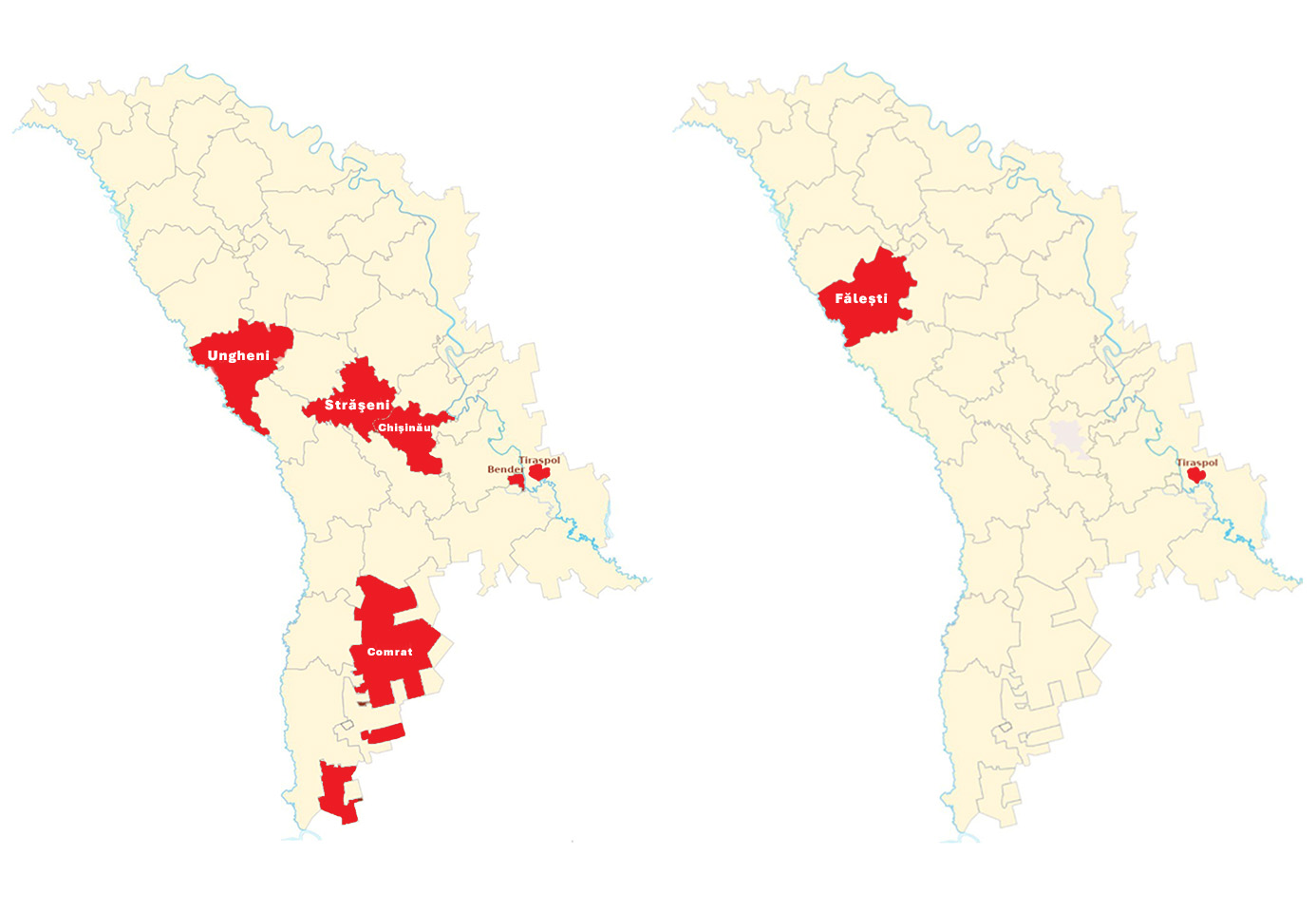Olga Sofronie, Olga Burduniuc, Greta Bălan
ECDC risk status: affected
(last edited: date 22.02.2024)
History and current situation
Tick-borne encephalitis is monitored in the Republic of Moldova with an emphasis on surveillance of ticks with no attention to human cases. The competent national institution responsible for TBE monitoring is the National Agency for Public Health. Official data on vector testing have been recorded since 2011. Ever since, studies on the circulation of the TBEV are conducted annually in spring, summer and autumn by collecting ticks from several regions of the country: Floreşti, Soroca, Bender, Tiraspol, Orhei, Drochia, Hînceşti, Ialoveni, Străşeni, Vadul lui Vodă, Chişinău, Taraclia, and Comrat territorial administrative units. TBEV was detected in most of the regions mentioned above, with highest isolation rates in Chişinău municipality (including Vadul lui Vodă), Străşeni, Comrat, Bender, and Tiraspol (Figure 1).
Tick testing was carried out using commercial ELISA sets for the detection of TBEV antigen (VectoTBEV-antigen; Novosibirsk, Russian Federation; https://en.vector-best.ru/catalog/IFA/kits/tick-borne-and-zoonotic-infections/). Tick species most frequently encountered in the territory of the Republic of Moldova are Ixodes ricinus, Dermacentor marginatus, Dermacentor reticulatus, Haemaphysalis inermis and Haemapysalis punctata, while I. ricinus was present in all of the three geographical areas. The average density index of the species I. ricinus in the period 2009-2011 was ~21 at the standard 200 m route.1
In a study conducted in 2010-2011 the Far Eastern TBEV subtype was detected by PCR in ticks (I. ricinus, Dermacentor spp. and Haemaphysalis spp.) collected from vegetation and domestic animals in Moldova. The regions where the presence of the TBEV-FE subtype was confirmed were Chişinău municipality and Ungheni district.2
Generally speaking, commercial ELISA kits for detection of antibodies to the TBEV are available for use in patients with CNS symptoms and a history of a tick bite in Moldova.3 Studies on TBEV-seroprevalence in humans have not been carried out yet and testing for TBEV-infection is not routinely integrated into medical practice. During 2018 and 2023, a total of only 11 patient sera were tested for antibodies against the TBEV. One was positive for anti-TBEV-IgM and one was positive for both, anti-TBEV-IgG and -IgM. The two patients were adults from different regions of the country (Făleşti, Tiraspol), and none of the two had a history of travel outside Moldova.
In summary, the risk for TBEV-infection in Moldova has been confirmed by (1) the presence of the appropriate vectors – ixodid ticks in different territories of the Republic of Moldova – and (2) by the presence of ticks infected with the TBEV (Far Eastern subtype); as well as (3) by documentation of (some) human cases in the past. There is clearly a need to increase awareness of TBE in Moldova along with appropriate surveillance to better define the circulation of the TBEV in the country.
Overview of TBE in Republic of Moldova
| Table 1: TBE in Moldova | |
|---|---|
| Viral subtypes isolated | Far-Eastern subtype2 |
| Reservoir animals | Information not available |
| Infected tick species (%) | Dermacentor reticulatus 3,9% (3/77)2 Ixodes ricinus 3,8% (3/78)2 Haemaphysalis punctate 8,8% (3/34)2 |
| Dairy product transmission | Not documented |
| Type of reporting | Not mandatory |
| Other TBE-surveillance | Not applicable |
| Special clinical features | Monophasic (limited data) Risk groups (no data) Clinical manifestation (limited data) |
| Licensed vaccines | None |
| Vaccination recommendations | None |
| Vaccine uptake | Unknown |
| National Reference center for TBE | National Agency for Public Health, Chişinău, MD-2028, 67A Gh. Asachi st. /https://ansp.md/ |
Figure 1: Regions of Moldova with TBEV detection in ticks and location of 2 confirmed cases
Note: (Ungheni, Străşeni, Comrat – district, Chişinău municipality, Bender, Tiraspol – towns)

Click the image above to enlarge
Acknowledgments
TBEV surveillance is supported by the National Public Health Agency (NAPH), Republic of Moldova and the Microbiology Laboratory, part of this agency. Information on collection and testing of ticks regarding human and non-human samples was provided by NAPH, Microbiology Laboratory.
Contact
Olga Sofronie
olga.sofronie@gmail.com
Authors
Olga Sofronie, Olga Burduniuc, Greta Bălan
Citation
Sofronie O, Burduniuc O, Bălan G. TBE in Moldova. Chapter 13. In: Dobler G, Erber W, Bröker M, Chitimia-Dobler L, Schmitt HJ, eds. The TBE Book. 7th ed. Singapore: Global Health Press; 2024. doi:10.33442/26613980_13-21-7
References
- Gheorghiţă S, Chicu V, Burlacu V, et al. Rolul căpuşelor Ixodes ricinus (Ixodidae) în menţinerea riscului de contractare a borreliozei Lyme în ecosistemele Republicii Moldova. Curierul Medical. 2012, 3(327):195-6.
- Ponomareva EP, Mikryukova TP, Gori AV, et al. Detection of Far-Eastern subtype of tick-borne encephalitis viral RNA in ticks collected in the Republic of Moldova. J Vector Borne Dis. 2015; 52(4):334-6.
- Sofronie O, Burlacu V. Tick-borne encephalitis virus – an emerging pathogen. One Health and Risk Management. 2023;(2023):44.